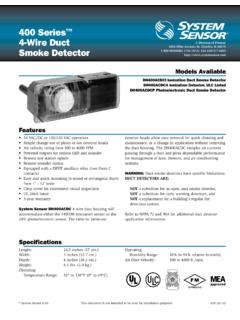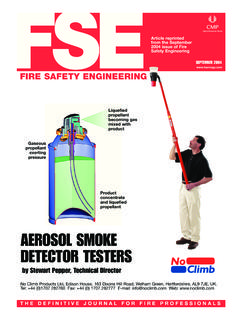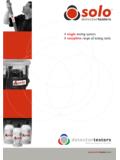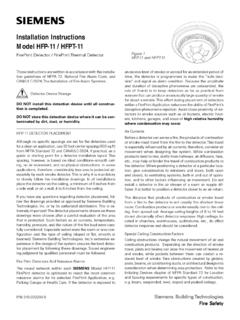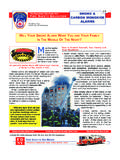Transcription of INSTALLATION AND MAINTENANCE INSTRUCTIONS FOR …
1 D100-50-00 Pittway Tecnologica , Via Caboto 19/3, 34147 Trieste, ItalyI56-2632-0061 TESTINGD etectors must be tested after INSTALLATION and following periodic , before testing, notify the proper authorities that the smoke detector systemis undergoing MAINTENANCE and the system will be temporarily out of the zone or system undergoing MAINTENANCE to prevent unwanted : If testing is carried out using non-intrinsically safe methods, itmust be conducted outside the hazardous the detector as follows:Test Magnet (Model M02-04-00 - optional) the detector by positioning the test magnet against the detector body approximately 2cm from LED1 in the direction of themetering socket (see Figure 1).
2 LEDs should latch on within 30 seconds, indicating an alarm and activating the Sensitivity Test (MOD400R)IMPORTANT: MOD400R is not intrinsically safe - the test must be conducted outside the hazardous the MOD400R Test Module with a digital or analogue voltmeter to check detector sensitivity as described in the test module completion of all tests notify the proper authorities that the system is that fail these tests should be cleaned as described under MAINTENANCE and re-tested. If the detectors still fail these tests theyshould be returned for cleaning, notify the proper authorities that the system is undergoing MAINTENANCE and will be temporarily out of service. Disable thesystem to prevent unwanted Detector has a plastic enclosure that may present an electrostatic risk and must not be installed in a position where it may besubject to a high dust-laden air flow.
3 Clean only with a damp cloth and do not the detector to be cleaned from the the detector cover (Note: Regulations in some countries may prohibit this operation on ionisation type sensors). Use a small flatblade screwdriver to gently release each of the four cover removal tabs that hold the cover in place. (See Figure 2) the outside of the screen carefully without removing the sensor screen. Pull the screen straight away from the sensing chamber until it snaps out of place. Replacement screens a vacuum cleaner and/or clean, compressed air to remove dust and debris from the sensing or replace the sensing chamber screen by sliding the edge without the tabs over the sensing chamber. Make sure that one of thescreen contacts engages with the PC board the detector cover.
4 Use the test module socket and LEDs to align the cover with the sensor assembly. Snap the cover into placemaking sure all tabs are all sensors have been cleaned, restore power to the system and test the sensor(s) as described in the TESTING section of OF smoke DETECTORSThis smoke detector is designed to activate and initiate emergency action but will do so only when used in conjunction with other detectors will not work without detectors will not sense fires which start where smoke does not reach the detectors. smoke from fires in chimneys, in walls, onroofs, or on the other side of closed doors may not reach the smoke detector and trigger the detector may not detect a fire developing on another level of a building.
5 For this reason, detectors should be located on every level of 1. Test Magnet 2. Sensor with Cover RemovedINSTALLATION AND MAINTENANCE INSTRUCTIONS FOR MODEL 1151 EISINTRINSICALLY SAFE LOW PROFILE IONISATION smoke DETECTORB efore installing the sensor, please thoroughly read System Sensor s Guide to Conventional Fire Systems. This manual includes detailedinformation on sensor spacing, placement, zoning, and special applications. Copies of this manual are available at no charge from System DESCRIPTIONM odel 1151 EIS ionisation smoke detectors use state-of-the-art sensing chambers and SMD circuitry for maximum reliability. These detectorsare designed to afford open area protection and are for use in hazardous areas where potentially explosive atmospheres are likely to arise.
6 Theclassification of equipment required must be confirmed with your responsible authority. 1151 EIS detectors are designed to be used withcompatible panels only and must be used in conjunction with a compatible zener barrier or galvanic LEDs on each detector light to provide a local 360 visible alarm indication. Remote LED annunciator capability is available as an optionalaccessory wired to the standard base terminals. These detectors also have a latching alarm feature. The alarm can be reset only by a momentarypower interruption. These detectors may be tested by activating an internal reed switch with a :Cover Height:43 mmCover Diameter:102 mmWeight:110 gOperating Temperature Range:-10 C to 40 CNote: Do not install in locations where the normal ambient temperature range extends beyond 0 C to 50 C for extended periodsOperating Humidity Range:10% to 93% Relative Humidity, Non-condensingIntrinsic Safety Rating: II 1 G EEx ia IIB T5 Latching Alarm.
7 Reset by momentary power detector has been independently tested and certified to EN54 part 7 and BASEEFA approved for intrinsic a general guide, the 1151 EIS smoke detector should provide adequate protection of an area 70-90m , where the ceiling is smooth and there isno significant air movement. Where INSTALLATION conditions or response requirements vary, different spacing may be necessary. It is essential toconsult local codes of practice for the INSTALLATION of fire alarm systems before installing smoke SELECTION AND WIRING GUIDER efer to the INSTALLATION INSTRUCTIONS supplied with the plug-in detector bases for wiring details. System Sensor detector bases B401 and B401 DGare available for this smoke bases are provided with screw terminals for power and remote indicator connections.
8 The electrical ratings for each detector-basecombination are also included in the base INSTALLATION :All wiring must conform to applicable local and national codes and :Verify that all detector bases are installed, that the detector monitoring circuits have been tested and that the wiring is correct. (Refer todetector base INSTRUCTIONS for testing procedure)WARNINGR emove power from detector monitoring circuits before installing the detector into the detector the detector clockwise with gentle pressure until the detector drops into rotating the detector clockwise to lock it in all detectors have been installed, apply power to the detector monitoring the detector as described under the detector at the system control the proper authorities that the system is in detector bases include a feature that, when activated, prevents removal of the detector without the use of a tool.
9 See the installationinstructions for the detector base for details of how to use this covers are fitted to the detectors to help protect units during shipment and when first installed. They are not intended toprovide complete protection against contamination; therefore detectors should be removed before beginning construction, majorre-decoration or other dust producing activity. Dust covers must be removed before the system can be made Tecnologica , Via Caboto 19/3, 34147 Trieste, ItalyI56-2632-0062 smoke detectors also have sensing limitations. Ionisation detectors offer broad range fire-sensing capability but they are better atdetecting fast, flaming fires than slow, smouldering fires. Photo-electronic detectors sense smouldering fires better than flaming fires develop in different ways and are often unpredictable in their growth, neither type of detector is necessarily better and agiven detector may not always provide warning of a fire.
10 In general, detectors can not be expected to provide warnings for fires resultingfrom inadequate fire protection practices, violent explosions, escaping gas, improper storage of flammable liquids like cleaning solvents,other safety hazards, or arson. smoke detectors used in high air velocity conditions may fail to alarm due to dilution of smoke densitiescreated by such frequent and rapid air exchanges. Additionally, high air velocity environments may create increased dust contamination,demanding more frequent detectors cannot last forever. smoke detectors contain electronic parts. Even though detectors are made to last over 10 years,any of these parts could fail at any time. Therefore, test your smoke detector system at least semi-annually.

